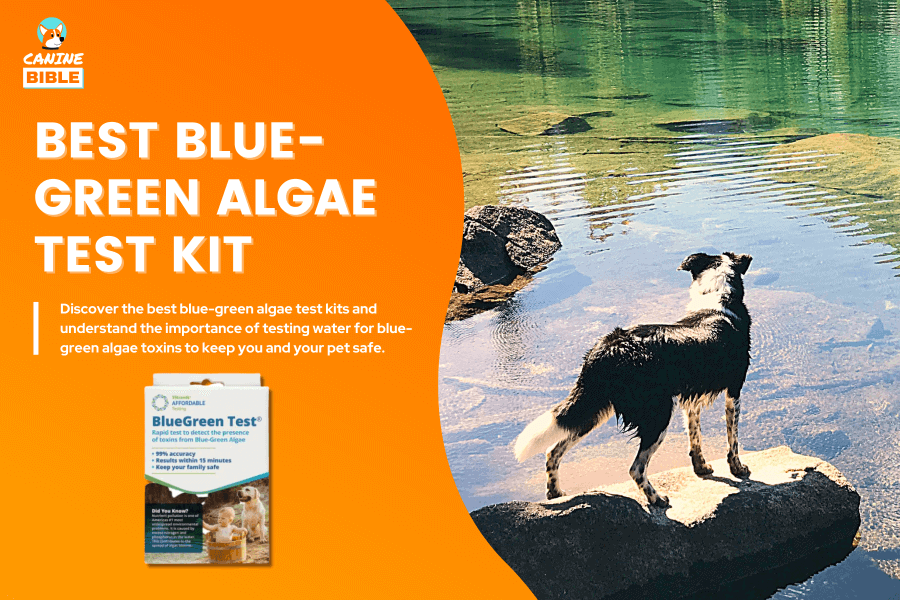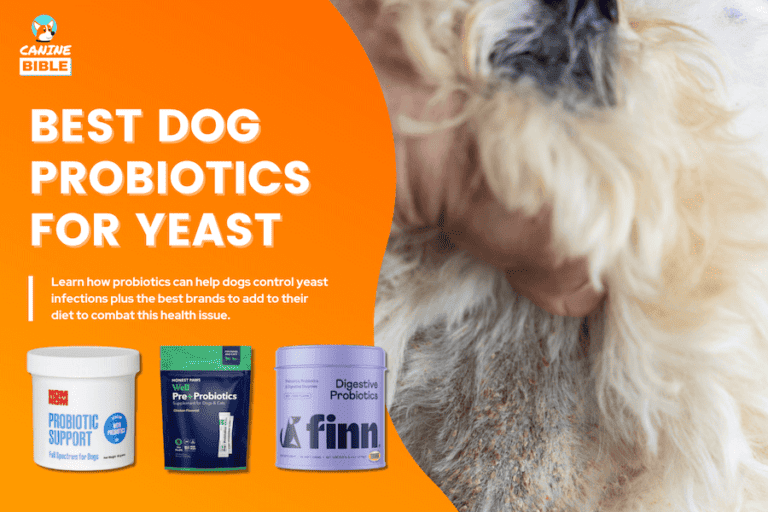Best Blue-Green Algae Test Kit: Its Importance For Dogs & People

Canine Bible is reader-supported. We receive affiliate commissions via some of our links. This doesn’t affect rankings. Learn more.
The presence of toxic blue-green algae, also known as cyanobacteria, in water bodies has become a growing concern for many. When ingested or even touched, this harmful algal bloom can pose significant health risks to humans and animals.
If you ever encountered a body of water and wondered, “Is this safe for my dog to swim in or drink from it?” that’s where blue-green algae test kits come in. These tests can provide a quick and easy way to ensure the safety of our water.
This article will explore what blue-green algae is, why testing for it is important, the process involved in testing, the best blue-green algae tests, and the necessary steps to take in case of detection. Let’s get started!
What Is Blue-Green Algae?
Despite its name, blue-green algae are not actually “algae” but bacteria that derive their energy through photosynthesis, just like plants.
Blue-green algae, scientifically called cyanobacteria, are naturally occurring microscopic organisms found in various water bodies, including lakes, streams, rivers, ponds, estuaries, and even ocean waters. Typically present in low quantities, these bacteria can proliferate rapidly in warm, shallow, undisturbed surface waters exposed to a lot of sunlight.
The Importance Of Blue-Green Algae Testing
Blue-green algae produce a variety of toxins called cyanotoxins. These toxins can be
The most common cyanotoxins in the U.S. are microcystins, which are liver toxins that can cause gastrointestinal illness in humans and animals.
Exposure to the toxins can be life-threatening to humans and other animals. There is no antidote for blue-green algae poisoning, which can rapidly become fatal.
Cyanotoxins have been implicated in human and animal illness and death in over fifty countries worldwide, including at least 35 U.S. States. Human toxicoses associated with cyanotoxins most commonly occur after exposure through drinking water or recreational activities.[1]
Blue-Green Algae & Harmful Algal Blooms
Under certain environmental conditions, blue-green algae (cyanobacteria) can multiply rapidly and form what’s known as Harmful Algal Blooms (HABs).
HABs can produce toxins that harm people, fish, shellfish, marine mammals, livestock and birds. Human illnesses caused by HABs can be debilitating or fatal. HABs can look like foam, scum, paint, or mats on the water’s surface. They can be different colors, including green, blue-green, red, or brown.
As climate change increases the frequency of heatwaves and alters rainfall patterns, HABs are also expected to rise, making testing for blue-green algae more crucial than ever.
Symptoms Of Blue-Geen Algae Exposure
Exposure to harmful blue-green algae, or cyanobacteria, can lead to a variety of symptoms in both humans and dogs. The symptoms largely depend on the type of toxin produced by the specific species of algae, the amount ingested or contacted, and the duration of exposure.
Blue-Geen Algae Symptoms In Humans.
Blue-Geen Algae Symptoms In Dogs:
Dogs are often at a higher risk of exposure because they may drink from contaminated water sources or lick their fur after swimming. Symptoms in dogs can appear within minutes to a few hours after exposure and include.
Blue-Green Algae Test Types & How They Work
Blue-green algae can be tested using various methods, from simple visual inspections and jar tests to more advanced laboratory-based procedures.
Preliminary Blue-Green Algae Test
This method can’t confirm the presence or determine the type or concentration of blue-green algae and should not be used to rule out the absence of blue-green algae.
Blue-Green Algae Test
These three tests can accurately help you detect the presence of blue-green algae to determine whether or not the water is safe for you and your pets.
Best Blue-Green Algae Test Kit
Here are the best blue-green algae tests you can perform.
Best Overall — 5strands Blue-Green Algae Test Kit

Why We Picked & Recommended It
The 5Strands Blue-Green Algae Test Kit is our top pick for the best blue-green algae test kit for its simplicity, effectiveness, and innovative technology.
This rapid diagnostic test detects a broad range of hepatotoxins on-site. This test kit employs a straightforward, single-step method known as a non-competitive immunocomplex assay. It uses a combination of antibodies that can identify molecular structures found in all prevalent cyanobacteria toxins. This unique blend allows the test to detect eleven commonly occurring hepatotoxins simultaneously. A single test can identify toxin levels even below 0.1 µg/L. (one-millionth of a gram per liter).
What Sets It Apart From Competitors
Unlike molecular and microscopic blue-green algae tests, this test usually takes 15 minutes to process with immediate, sensitive, and indicative results. This test kit sets itself apart by being the world’s first rapid diagnostic test to detect a broad range of hepatotoxins on-site, and it’s as accurate as other tests.
Key Features
Looking for a 5Strands discount code? Our readers get 10% off their total order by using CanineBible at checkout. Click here to get started.
At-Home Blue-Green Algae Test — DIY Jar Test
The Kansas Department of Health & Environment recommends the jar test is a simple preliminary test.[2] This is a common method used to determine the presence of blue-green algae in a body of water. However, the results are not definitive. It can give an initial indication but not the concentration or whether the blue-green algae present are producing toxins.
Here’s a step-by-step guide on how to perform the jar test:
Materials Needed
Procedure
Handle the water sample with care, as it may contain harmful toxins. If possible, use gloves and wash your hands thoroughly after handling the sample.
Interpreting Results
After 24 hours, carefully observe the jar. Don’t agitate and mix the water. Take the jar out and look to see where the algae have accumulated.
What To Do If You Detect Blue-Green Algae?
Here’s what to do if you detect or suspect the presence of blue-green algae.
What To Do If My Dog Was Exposed To Blue-Green Algae
If you suspect your dog has been exposed to blue-green algae, it’s important to take immediate action as the toxins produced by these algae can be harmful or even fatal to pets:
Other Water Safety Test For Dogs
For dog owners who are anxious about the quality of the water their pets drink, we recommend a test like My Pet Water Quality Test Kit. This test is designed to test any fresh water source, including tap water, for things like chlorine, alkalinity, fluoride, lead, mercury, pesticides, and hardness level. These kits can test fresh water supplies for drinkability, including chemically-treated city water.
In most cases, bodies of water may be perfectly safe for your dog to drink. However, during outdoor excursions, you’re better off giving your pooch bottled water that you know is safe. To that end, a portable dog water bottle is a handy tool.
Ultimately, a water test kit is most useful for pet parents wary about the risks of blue-green algae blooms. If you and your canine companion frequently discover new spots for swimming, incorporating an algae test such as the one provided by 5Strands into your outdoor pet supplies would be a wise move
Blue-Green Algae Test Kit — Conclusion
Can dog parents benefit from using a blue-green algae test? Absolutely.
Blue-gree algae test empowers us to identify potential harmful algal blooms and promptly prevent possible exposure, especially during the warm months when these blooms are most prevalent. Despite their inherent limitations, these test kits provide an essential first line of defense in maintaining the safety of our water bodies, be it a household’s tap water, a local pond, or a favorite swimming spot.
They are practical for outdoor enthusiasts who frequently enjoy water-related activities with their pets and for all pet parents who want to ensure their pets’ well-being. That said, it’s essential to understand that while these kits offer a valuable indication of water safety, any suspected presence of harmful blue-green algae should always be reported to local health or environmental authorities for professional assessment and necessary action.
Combining individual vigilance and professional oversight is the best approach to protect ourselves, our beloved pets, and our community from the risks of blue-green algae.
Like It? Subscribe & Share!
Canine Bible authorship represents the unified voice of our entire editorial team and our in-house veterinarians rather than a single author. Each article, blog post, and review published under the Canine Bible name undergoes a rigorous review process, involving all team members to guarantee accuracy and up-to-date in accordance with the latest veterinarian research. This collaborative effort is an integral part of our editorial process and aligns with our four pillars of content creation. This approach ensures our content is backed by expert knowledge and factual information, offering our readers reliable, actionable, and trustworthy content.








